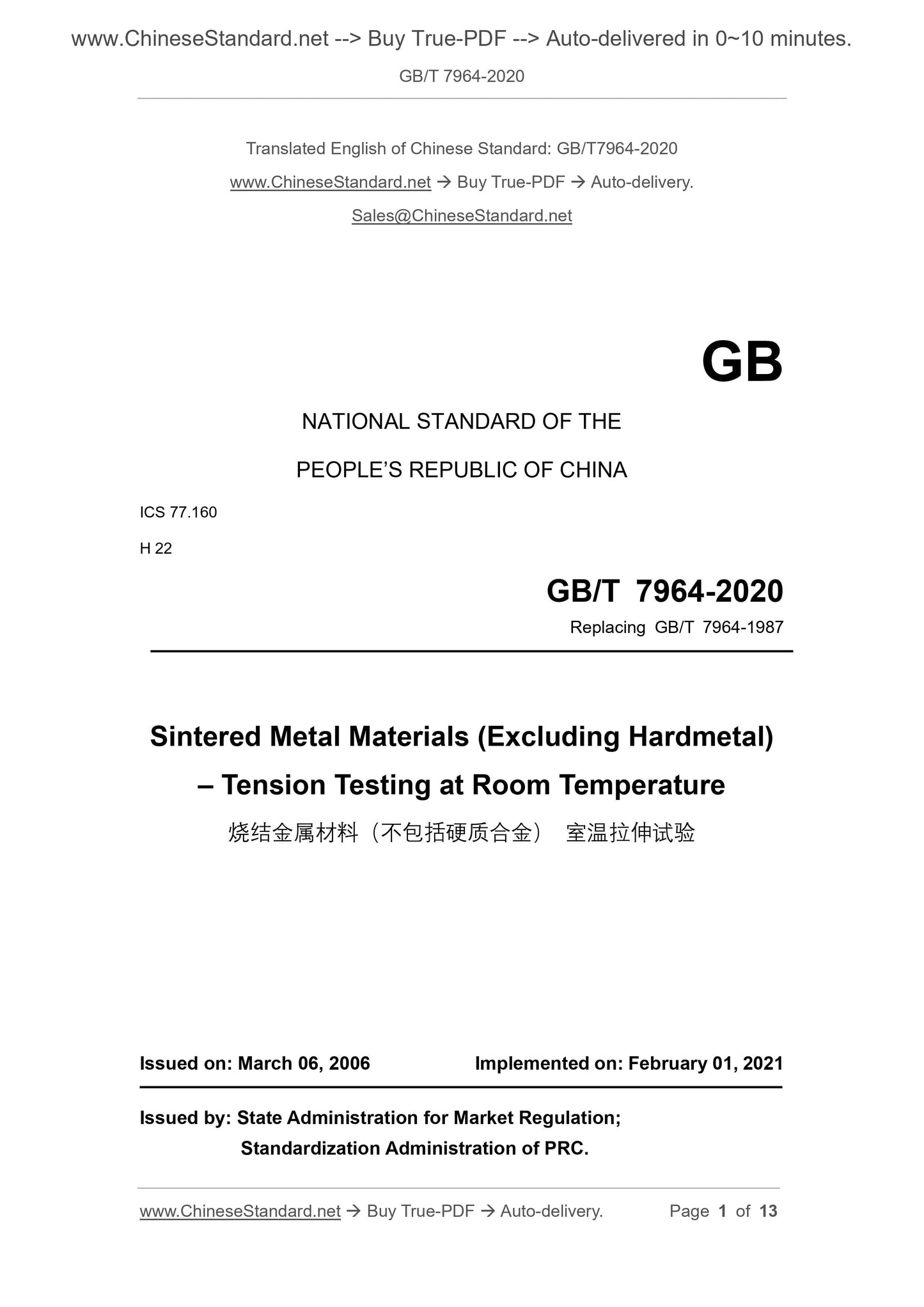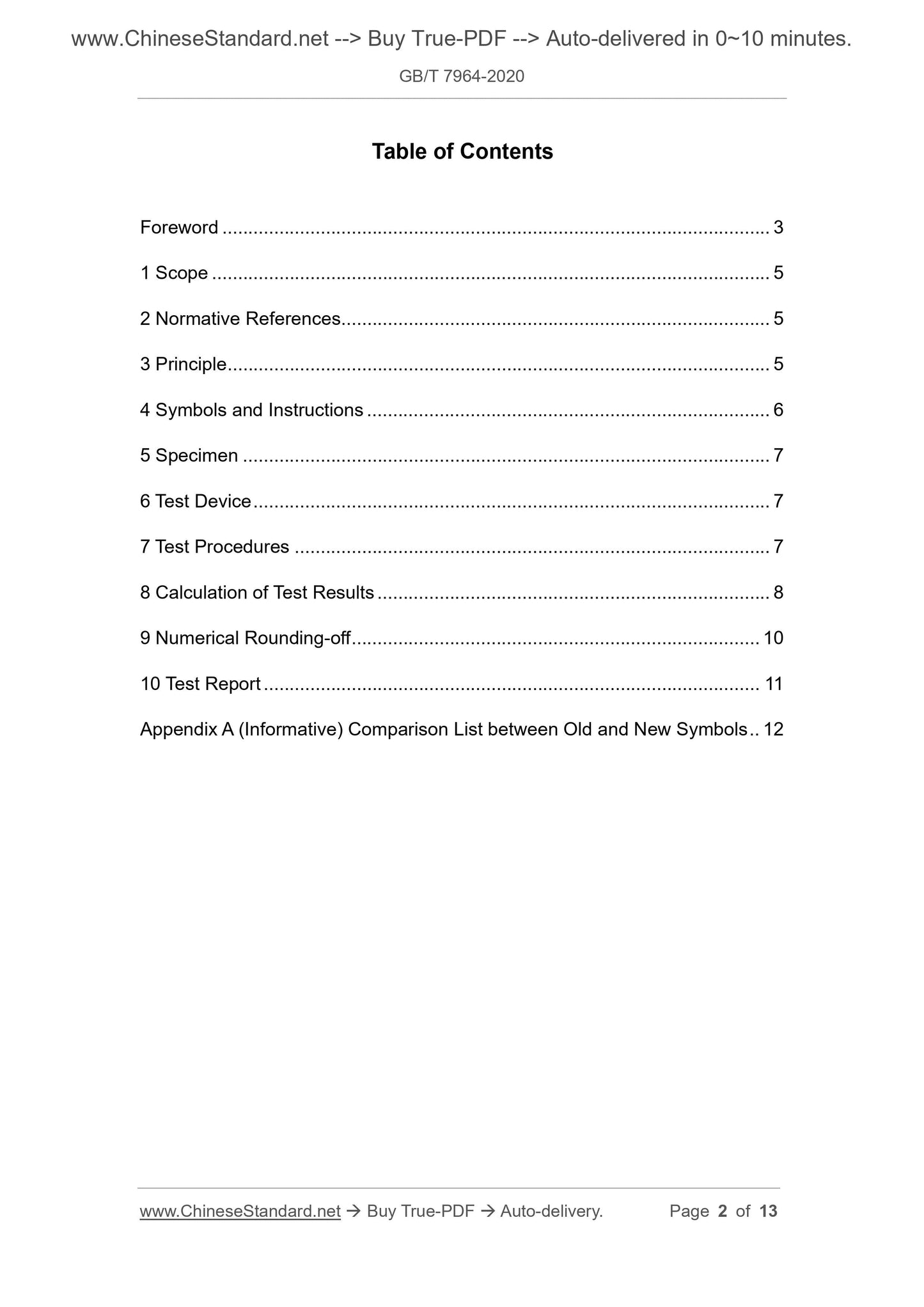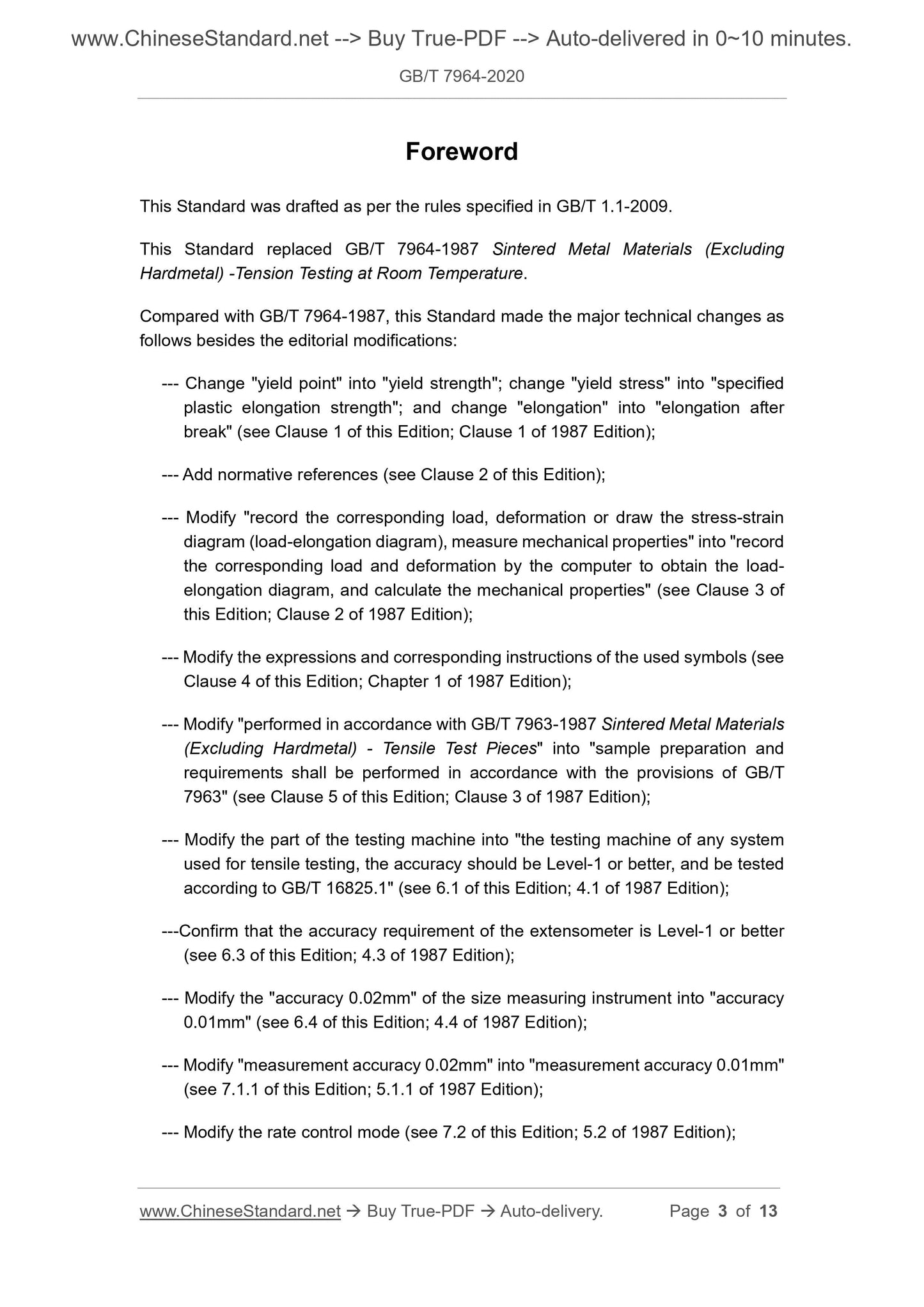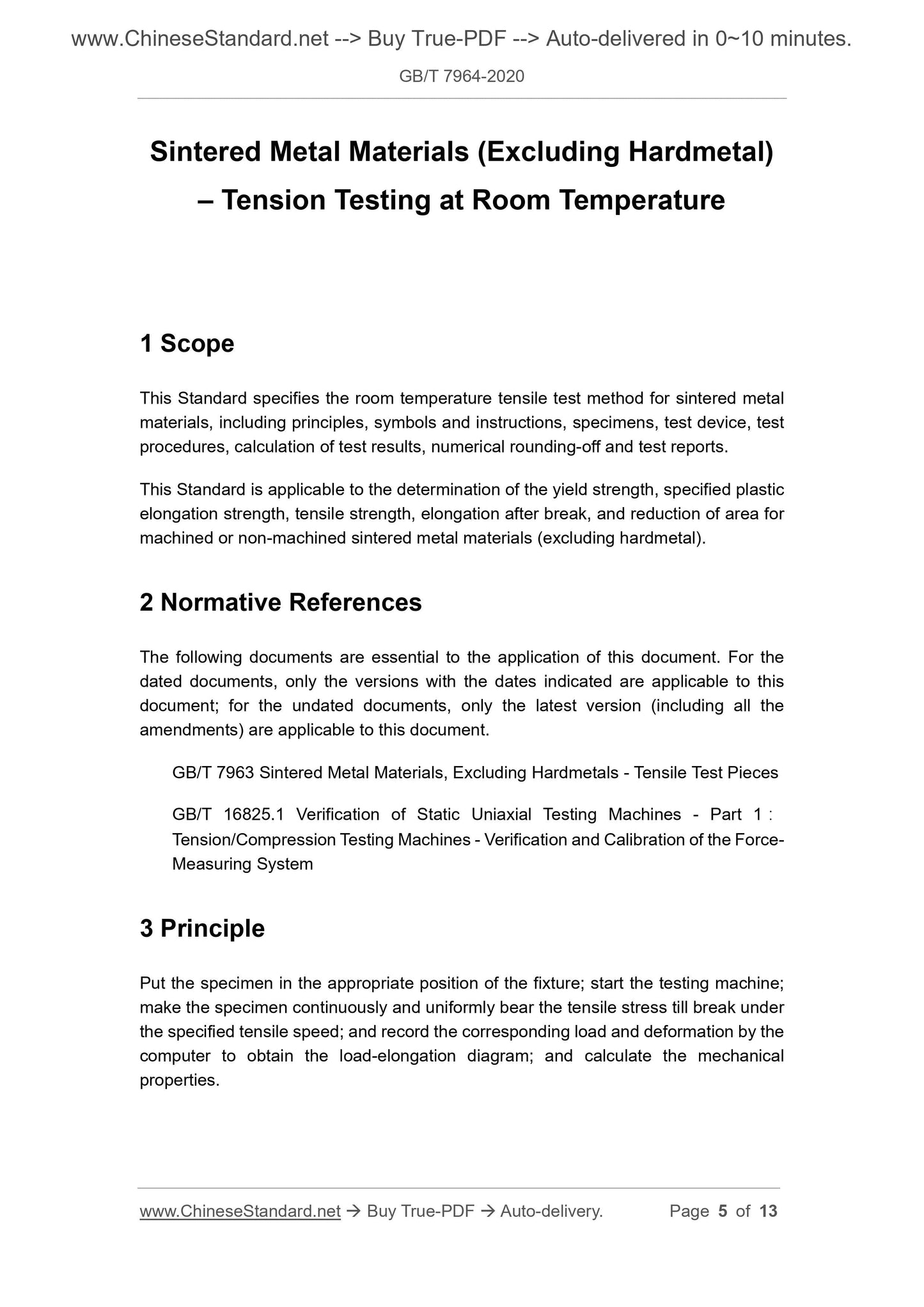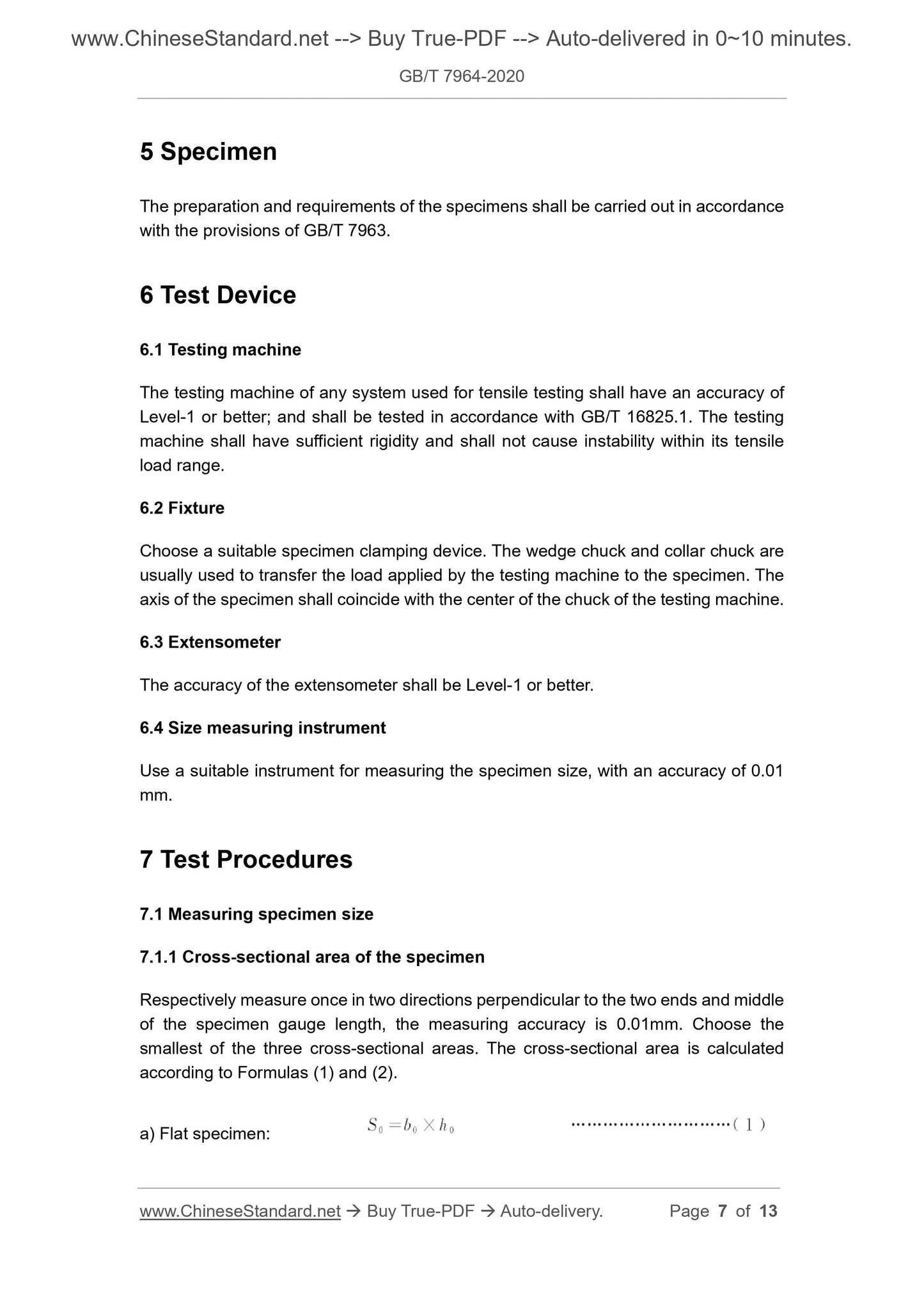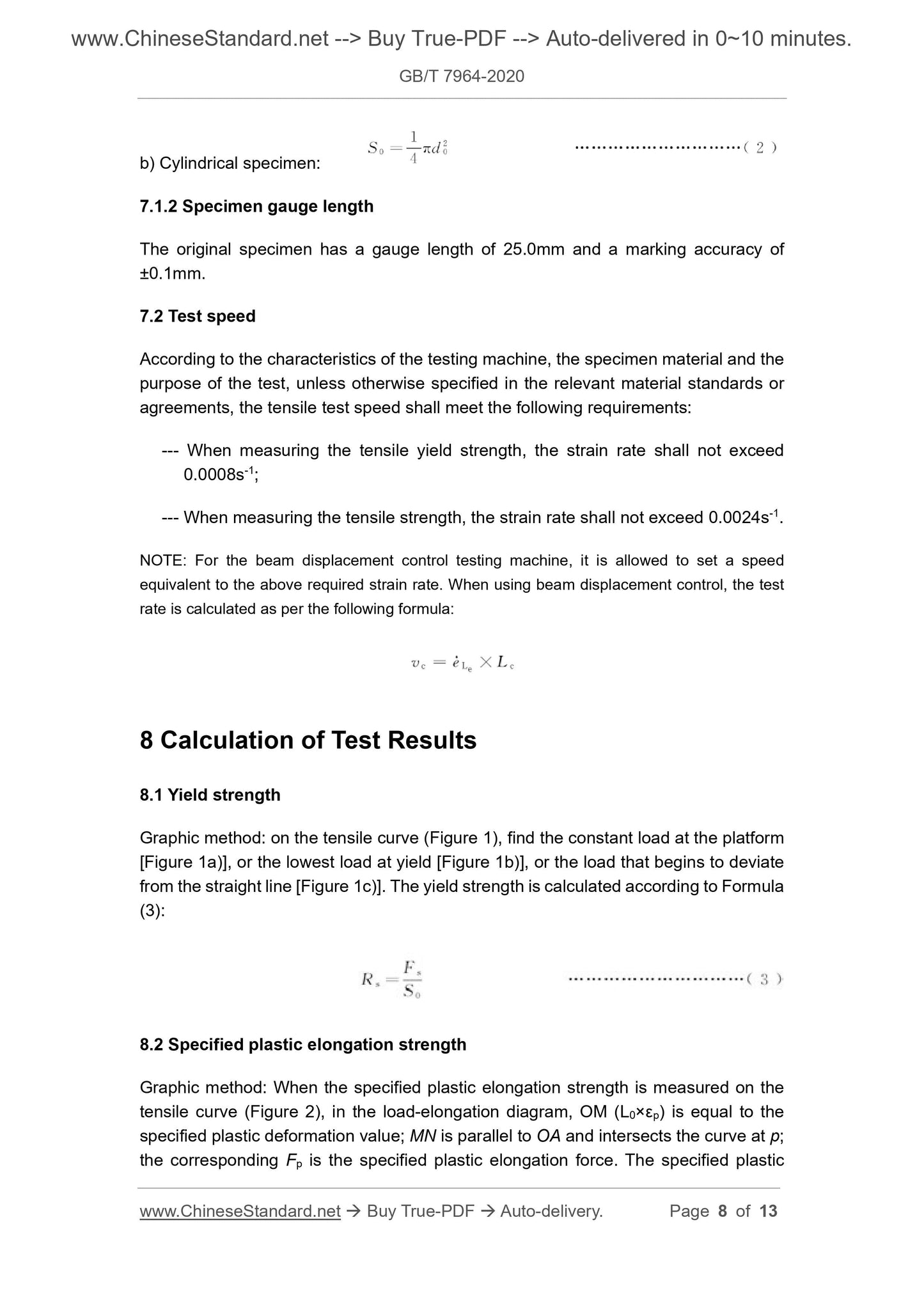1
/
of
6
www.ChineseStandard.us -- Field Test Asia Pte. Ltd.
GB/T 7964-2020 English PDF (GB/T7964-2020)
GB/T 7964-2020 English PDF (GB/T7964-2020)
Regular price
$145.00
Regular price
Sale price
$145.00
Unit price
/
per
Shipping calculated at checkout.
Couldn't load pickup availability
GB/T 7964-2020: Sintered Metal Materials (Excluding Hardmetal) - Tension Testing at Room Temperature
Delivery: 9 seconds. Download (& Email) true-PDF + Invoice.
Get Quotation: Click GB/T 7964-2020 (Self-service in 1-minute)
Historical versions (Master-website): GB/T 7964-2020
Preview True-PDF (Reload/Scroll-down if blank)
GB/T 7964-2020
NATIONAL STANDARD OF THE
PEOPLE’S REPUBLIC OF CHINA
ICS 77.160
H 22
Replacing GB/T 7964-1987
Sintered Metal Materials (Excluding Hardmetal)
– Tension Testing at Room Temperature
ISSUED ON: MARCH 06, 2006
IMPLEMENTED ON: FEBRUARY 01, 2021
Issued by: State Administration for Market Regulation;
Standardization Administration of PRC.
Table of Contents
Foreword ... 3
1 Scope ... 5
2 Normative References ... 5
3 Principle ... 5
4 Symbols and Instructions ... 6
5 Specimen ... 7
6 Test Device ... 7
7 Test Procedures ... 7
8 Calculation of Test Results ... 8
9 Numerical Rounding-off ... 10
10 Test Report ... 11
Appendix A (Informative) Comparison List between Old and New Symbols .. 12
Foreword
This Standard was drafted as per the rules specified in GB/T 1.1-2009.
This Standard replaced GB/T 7964-1987 Sintered Metal Materials (Excluding
Hardmetal) -Tension Testing at Room Temperature.
Compared with GB/T 7964-1987, this Standard made the major technical changes as
follows besides the editorial modifications:
--- Change "yield point" into "yield strength"; change "yield stress" into "specified
plastic elongation strength"; and change "elongation" into "elongation after
break" (see Clause 1 of this Edition; Clause 1 of 1987 Edition);
--- Add normative references (see Clause 2 of this Edition);
--- Modify "record the corresponding load, deformation or draw the stress-strain
diagram (load-elongation diagram), measure mechanical properties" into "record
the corresponding load and deformation by the computer to obtain the load-
elongation diagram, and calculate the mechanical properties" (see Clause 3 of
this Edition; Clause 2 of 1987 Edition);
--- Modify the expressions and corresponding instructions of the used symbols (see
Clause 4 of this Edition; Chapter 1 of 1987 Edition);
--- Modify "performed in accordance with GB/T 7963-1987 Sintered Metal Materials
(Excluding Hardmetal) - Tensile Test Pieces" into "sample preparation and
requirements shall be performed in accordance with the provisions of GB/T
7963" (see Clause 5 of this Edition; Clause 3 of 1987 Edition);
--- Modify the part of the testing machine into "the testing machine of any system
used for tensile testing, the accuracy should be Level-1 or better, and be tested
according to GB/T 16825.1" (see 6.1 of this Edition; 4.1 of 1987 Edition);
---Confirm that the accuracy requirement of the extensometer is Level-1 or better
(see 6.3 of this Edition; 4.3 of 1987 Edition);
--- Modify the "accuracy 0.02mm" of the size measuring instrument into "accuracy
0.01mm" (see 6.4 of this Edition; 4.4 of 1987 Edition);
--- Modify "measurement accuracy 0.02mm" into "measurement accuracy 0.01mm"
(see 7.1.1 of this Edition; 5.1.1 of 1987 Edition);
--- Modify the rate control mode (see 7.2 of this Edition; 5.2 of 1987 Edition);
Sintered Metal Materials (Excluding Hardmetal)
– Tension Testing at Room Temperature
1 Scope
This Standard specifies the room temperature tensile test method for sintered metal
materials, including principles, symbols and instructions, specimens, test device, test
procedures, calculation of test results, numerical rounding-off and test reports.
This Standard is applicable to the determination of the yield strength, specified plastic
elongation strength, tensile strength, elongation after break, and reduction of area for
machined or non-machined sintered metal materials (excluding hardmetal).
2 Normative References
The following documents are essential to the application of this document. For the
dated documents, only the versions with the dates indicated are applicable to this
document; for the undated documents, only the latest version (including all the
amendments) are applicable to this document.
GB/T 7963 Sintered Metal Materials, Excluding Hardmetals - Tensile Test Pieces
GB/T 16825.1 Verification of Static Uniaxial Testing Machines - Part 1 :
Tension/Compression Testing Machines - Verification and Calibration of the Force-
Measuring System
3 Principle
Put the specimen in the appropriate position of the fixture; start the testing machine;
make the specimen continuously and uniformly bear the tensile stress till break under
the specified tensile speed; and record the corresponding load and deformation by the
computer to obtain the load-elongation diagram; and calculate the mechanical
properties.
5 Specimen
The preparation and requirements of the specimens shall be carried out in accordance
with the provisions of GB/T 7963.
6 Test Device
6.1 Testing machine
The testing machine of any system used for tensile testing shall have an accuracy of
Level-1 or better; and shall be tested in accordance with GB/T 16825.1. The testing
machine shall have sufficient rigidity and shall not cause instability within its tensile
load range.
6.2 Fixture
Choose a suitable specimen clamping device. The wedge chuck and collar chuck are
usually used to transfer the load applied by the testing machine to the specimen. The
axis of the specimen shall coincide with the center of the chuck of the testing machine.
6.3 Extensometer
The accuracy of the extensometer shall be Level-1 or better.
6.4 Size measuring instrument
Use a suitable instrument for measuring the specimen size, with an accuracy of 0.01
mm.
7 Test Procedures
7.1 Measuring specimen size
7.1.1 Cross-sectional area of the specimen
Respectively measure once in two directions perpendicular to the two ends and middle
of the specimen gauge length, the measuring accuracy is 0.01mm. Choose the
smallest of the three cross-sectional areas. The cross-sectional area is calculated
according to Formulas (1) and (2).
a) Flat specimen:
b) Cylindrical specimen:
7.1.2 Specimen gauge length
The original specimen has a gauge length of 25.0mm and a marking accuracy of
±0.1mm.
7.2 Test speed
According to the characteristics of the testing machine, the specimen material and the
purpose of the test, unless otherwise specified in the relevant material standards or
agreements, the tensile test speed shall meet the following requirements:
--- When measuring the tensile yield strength, the strain rate shall not exceed
0.0008s-1;
--- When measuring the tensile strength, the strain rate shall not exceed 0.0024s-1.
NOTE: For the beam displacement control testing machine, it is allowed to set a speed
equivalent to the above required strain rate. When using beam displacement control, the test
rate is calculated as per the following formula:
8 Calculation of Test Results
8.1 Yield strength
Graphic method: on the tensile curve (Figure 1), find the constant load at the platform
[Figure 1a)], or the lowest load at yield [Figure 1b)], or the load that begins to deviate
from the straight line [Figure 1c)]. The yield strength is calculated according to Formula
(3):
8.2 Specified plastic elongation strength
Graphic method: When the specified plastic elongation strength is measured on the
tensile curve (Figure 2), in the load-elongation diagram, OM (L0×εp) is equal to the
specified plastic deformation value; MN is parallel to OA and intersects the curve at p;
the corresponding Fp is the specified plastic elongation force. The specified plastic
GB/T 7964-2020
NATIONAL STANDARD OF THE
PEOPLE’S REPUBLIC OF CHINA
ICS 77.160
H 22
Replacing GB/T 7964-1987
Sintered Metal Materials (Excluding Hardmetal)
– Tension Testing at Room Temperature
ISSUED ON: MARCH 06, 2006
IMPLEMENTED ON: FEBRUARY 01, 2021
Issued by: State Administration for Market Regulation;
Standardization Administration of PRC.
Table of Contents
Foreword ... 3
1 Scope ... 5
2 Normative References ... 5
3 Principle ... 5
4 Symbols and Instructions ... 6
5 Specimen ... 7
6 Test Device ... 7
7 Test Procedures ... 7
8 Calculation of Test Results ... 8
9 Numerical Rounding-off ... 10
10 Test Report ... 11
Appendix A (Informative) Comparison List between Old and New Symbols .. 12
Foreword
This Standard was drafted as per the rules specified in GB/T 1.1-2009.
This Standard replaced GB/T 7964-1987 Sintered Metal Materials (Excluding
Hardmetal) -Tension Testing at Room Temperature.
Compared with GB/T 7964-1987, this Standard made the major technical changes as
follows besides the editorial modifications:
--- Change "yield point" into "yield strength"; change "yield stress" into "specified
plastic elongation strength"; and change "elongation" into "elongation after
break" (see Clause 1 of this Edition; Clause 1 of 1987 Edition);
--- Add normative references (see Clause 2 of this Edition);
--- Modify "record the corresponding load, deformation or draw the stress-strain
diagram (load-elongation diagram), measure mechanical properties" into "record
the corresponding load and deformation by the computer to obtain the load-
elongation diagram, and calculate the mechanical properties" (see Clause 3 of
this Edition; Clause 2 of 1987 Edition);
--- Modify the expressions and corresponding instructions of the used symbols (see
Clause 4 of this Edition; Chapter 1 of 1987 Edition);
--- Modify "performed in accordance with GB/T 7963-1987 Sintered Metal Materials
(Excluding Hardmetal) - Tensile Test Pieces" into "sample preparation and
requirements shall be performed in accordance with the provisions of GB/T
7963" (see Clause 5 of this Edition; Clause 3 of 1987 Edition);
--- Modify the part of the testing machine into "the testing machine of any system
used for tensile testing, the accuracy should be Level-1 or better, and be tested
according to GB/T 16825.1" (see 6.1 of this Edition; 4.1 of 1987 Edition);
---Confirm that the accuracy requirement of the extensometer is Level-1 or better
(see 6.3 of this Edition; 4.3 of 1987 Edition);
--- Modify the "accuracy 0.02mm" of the size measuring instrument into "accuracy
0.01mm" (see 6.4 of this Edition; 4.4 of 1987 Edition);
--- Modify "measurement accuracy 0.02mm" into "measurement accuracy 0.01mm"
(see 7.1.1 of this Edition; 5.1.1 of 1987 Edition);
--- Modify the rate control mode (see 7.2 of this Edition; 5.2 of 1987 Edition);
Sintered Metal Materials (Excluding Hardmetal)
– Tension Testing at Room Temperature
1 Scope
This Standard specifies the room temperature tensile test method for sintered metal
materials, including principles, symbols and instructions, specimens, test device, test
procedures, calculation of test results, numerical rounding-off and test reports.
This Standard is applicable to the determination of the yield strength, specified plastic
elongation strength, tensile strength, elongation after break, and reduction of area for
machined or non-machined sintered metal materials (excluding hardmetal).
2 Normative References
The following documents are essential to the application of this document. For the
dated documents, only the versions with the dates indicated are applicable to this
document; for the undated documents, only the latest version (including all the
amendments) are applicable to this document.
GB/T 7963 Sintered Metal Materials, Excluding Hardmetals - Tensile Test Pieces
GB/T 16825.1 Verification of Static Uniaxial Testing Machines - Part 1 :
Tension/Compression Testing Machines - Verification and Calibration of the Force-
Measuring System
3 Principle
Put the specimen in the appropriate position of the fixture; start the testing machine;
make the specimen continuously and uniformly bear the tensile stress till break under
the specified tensile speed; and record the corresponding load and deformation by the
computer to obtain the load-elongation diagram; and calculate the mechanical
properties.
5 Specimen
The preparation and requirements of the specimens shall be carried out in accordance
with the provisions of GB/T 7963.
6 Test Device
6.1 Testing machine
The testing machine of any system used for tensile testing shall have an accuracy of
Level-1 or better; and shall be tested in accordance with GB/T 16825.1. The testing
machine shall have sufficient rigidity and shall not cause instability within its tensile
load range.
6.2 Fixture
Choose a suitable specimen clamping device. The wedge chuck and collar chuck are
usually used to transfer the load applied by the testing machine to the specimen. The
axis of the specimen shall coincide with the center of the chuck of the testing machine.
6.3 Extensometer
The accuracy of the extensometer shall be Level-1 or better.
6.4 Size measuring instrument
Use a suitable instrument for measuring the specimen size, with an accuracy of 0.01
mm.
7 Test Procedures
7.1 Measuring specimen size
7.1.1 Cross-sectional area of the specimen
Respectively measure once in two directions perpendicular to the two ends and middle
of the specimen gauge length, the measuring accuracy is 0.01mm. Choose the
smallest of the three cross-sectional areas. The cross-sectional area is calculated
according to Formulas (1) and (2).
a) Flat specimen:
b) Cylindrical specimen:
7.1.2 Specimen gauge length
The original specimen has a gauge length of 25.0mm and a marking accuracy of
±0.1mm.
7.2 Test speed
According to the characteristics of the testing machine, the specimen material and the
purpose of the test, unless otherwise specified in the relevant material standards or
agreements, the tensile test speed shall meet the following requirements:
--- When measuring the tensile yield strength, the strain rate shall not exceed
0.0008s-1;
--- When measuring the tensile strength, the strain rate shall not exceed 0.0024s-1.
NOTE: For the beam displacement control testing machine, it is allowed to set a speed
equivalent to the above required strain rate. When using beam displacement control, the test
rate is calculated as per the following formula:
8 Calculation of Test Results
8.1 Yield strength
Graphic method: on the tensile curve (Figure 1), find the constant load at the platform
[Figure 1a)], or the lo...
Delivery: 9 seconds. Download (& Email) true-PDF + Invoice.
Get Quotation: Click GB/T 7964-2020 (Self-service in 1-minute)
Historical versions (Master-website): GB/T 7964-2020
Preview True-PDF (Reload/Scroll-down if blank)
GB/T 7964-2020
NATIONAL STANDARD OF THE
PEOPLE’S REPUBLIC OF CHINA
ICS 77.160
H 22
Replacing GB/T 7964-1987
Sintered Metal Materials (Excluding Hardmetal)
– Tension Testing at Room Temperature
ISSUED ON: MARCH 06, 2006
IMPLEMENTED ON: FEBRUARY 01, 2021
Issued by: State Administration for Market Regulation;
Standardization Administration of PRC.
Table of Contents
Foreword ... 3
1 Scope ... 5
2 Normative References ... 5
3 Principle ... 5
4 Symbols and Instructions ... 6
5 Specimen ... 7
6 Test Device ... 7
7 Test Procedures ... 7
8 Calculation of Test Results ... 8
9 Numerical Rounding-off ... 10
10 Test Report ... 11
Appendix A (Informative) Comparison List between Old and New Symbols .. 12
Foreword
This Standard was drafted as per the rules specified in GB/T 1.1-2009.
This Standard replaced GB/T 7964-1987 Sintered Metal Materials (Excluding
Hardmetal) -Tension Testing at Room Temperature.
Compared with GB/T 7964-1987, this Standard made the major technical changes as
follows besides the editorial modifications:
--- Change "yield point" into "yield strength"; change "yield stress" into "specified
plastic elongation strength"; and change "elongation" into "elongation after
break" (see Clause 1 of this Edition; Clause 1 of 1987 Edition);
--- Add normative references (see Clause 2 of this Edition);
--- Modify "record the corresponding load, deformation or draw the stress-strain
diagram (load-elongation diagram), measure mechanical properties" into "record
the corresponding load and deformation by the computer to obtain the load-
elongation diagram, and calculate the mechanical properties" (see Clause 3 of
this Edition; Clause 2 of 1987 Edition);
--- Modify the expressions and corresponding instructions of the used symbols (see
Clause 4 of this Edition; Chapter 1 of 1987 Edition);
--- Modify "performed in accordance with GB/T 7963-1987 Sintered Metal Materials
(Excluding Hardmetal) - Tensile Test Pieces" into "sample preparation and
requirements shall be performed in accordance with the provisions of GB/T
7963" (see Clause 5 of this Edition; Clause 3 of 1987 Edition);
--- Modify the part of the testing machine into "the testing machine of any system
used for tensile testing, the accuracy should be Level-1 or better, and be tested
according to GB/T 16825.1" (see 6.1 of this Edition; 4.1 of 1987 Edition);
---Confirm that the accuracy requirement of the extensometer is Level-1 or better
(see 6.3 of this Edition; 4.3 of 1987 Edition);
--- Modify the "accuracy 0.02mm" of the size measuring instrument into "accuracy
0.01mm" (see 6.4 of this Edition; 4.4 of 1987 Edition);
--- Modify "measurement accuracy 0.02mm" into "measurement accuracy 0.01mm"
(see 7.1.1 of this Edition; 5.1.1 of 1987 Edition);
--- Modify the rate control mode (see 7.2 of this Edition; 5.2 of 1987 Edition);
Sintered Metal Materials (Excluding Hardmetal)
– Tension Testing at Room Temperature
1 Scope
This Standard specifies the room temperature tensile test method for sintered metal
materials, including principles, symbols and instructions, specimens, test device, test
procedures, calculation of test results, numerical rounding-off and test reports.
This Standard is applicable to the determination of the yield strength, specified plastic
elongation strength, tensile strength, elongation after break, and reduction of area for
machined or non-machined sintered metal materials (excluding hardmetal).
2 Normative References
The following documents are essential to the application of this document. For the
dated documents, only the versions with the dates indicated are applicable to this
document; for the undated documents, only the latest version (including all the
amendments) are applicable to this document.
GB/T 7963 Sintered Metal Materials, Excluding Hardmetals - Tensile Test Pieces
GB/T 16825.1 Verification of Static Uniaxial Testing Machines - Part 1 :
Tension/Compression Testing Machines - Verification and Calibration of the Force-
Measuring System
3 Principle
Put the specimen in the appropriate position of the fixture; start the testing machine;
make the specimen continuously and uniformly bear the tensile stress till break under
the specified tensile speed; and record the corresponding load and deformation by the
computer to obtain the load-elongation diagram; and calculate the mechanical
properties.
5 Specimen
The preparation and requirements of the specimens shall be carried out in accordance
with the provisions of GB/T 7963.
6 Test Device
6.1 Testing machine
The testing machine of any system used for tensile testing shall have an accuracy of
Level-1 or better; and shall be tested in accordance with GB/T 16825.1. The testing
machine shall have sufficient rigidity and shall not cause instability within its tensile
load range.
6.2 Fixture
Choose a suitable specimen clamping device. The wedge chuck and collar chuck are
usually used to transfer the load applied by the testing machine to the specimen. The
axis of the specimen shall coincide with the center of the chuck of the testing machine.
6.3 Extensometer
The accuracy of the extensometer shall be Level-1 or better.
6.4 Size measuring instrument
Use a suitable instrument for measuring the specimen size, with an accuracy of 0.01
mm.
7 Test Procedures
7.1 Measuring specimen size
7.1.1 Cross-sectional area of the specimen
Respectively measure once in two directions perpendicular to the two ends and middle
of the specimen gauge length, the measuring accuracy is 0.01mm. Choose the
smallest of the three cross-sectional areas. The cross-sectional area is calculated
according to Formulas (1) and (2).
a) Flat specimen:
b) Cylindrical specimen:
7.1.2 Specimen gauge length
The original specimen has a gauge length of 25.0mm and a marking accuracy of
±0.1mm.
7.2 Test speed
According to the characteristics of the testing machine, the specimen material and the
purpose of the test, unless otherwise specified in the relevant material standards or
agreements, the tensile test speed shall meet the following requirements:
--- When measuring the tensile yield strength, the strain rate shall not exceed
0.0008s-1;
--- When measuring the tensile strength, the strain rate shall not exceed 0.0024s-1.
NOTE: For the beam displacement control testing machine, it is allowed to set a speed
equivalent to the above required strain rate. When using beam displacement control, the test
rate is calculated as per the following formula:
8 Calculation of Test Results
8.1 Yield strength
Graphic method: on the tensile curve (Figure 1), find the constant load at the platform
[Figure 1a)], or the lowest load at yield [Figure 1b)], or the load that begins to deviate
from the straight line [Figure 1c)]. The yield strength is calculated according to Formula
(3):
8.2 Specified plastic elongation strength
Graphic method: When the specified plastic elongation strength is measured on the
tensile curve (Figure 2), in the load-elongation diagram, OM (L0×εp) is equal to the
specified plastic deformation value; MN is parallel to OA and intersects the curve at p;
the corresponding Fp is the specified plastic elongation force. The specified plastic
GB/T 7964-2020
NATIONAL STANDARD OF THE
PEOPLE’S REPUBLIC OF CHINA
ICS 77.160
H 22
Replacing GB/T 7964-1987
Sintered Metal Materials (Excluding Hardmetal)
– Tension Testing at Room Temperature
ISSUED ON: MARCH 06, 2006
IMPLEMENTED ON: FEBRUARY 01, 2021
Issued by: State Administration for Market Regulation;
Standardization Administration of PRC.
Table of Contents
Foreword ... 3
1 Scope ... 5
2 Normative References ... 5
3 Principle ... 5
4 Symbols and Instructions ... 6
5 Specimen ... 7
6 Test Device ... 7
7 Test Procedures ... 7
8 Calculation of Test Results ... 8
9 Numerical Rounding-off ... 10
10 Test Report ... 11
Appendix A (Informative) Comparison List between Old and New Symbols .. 12
Foreword
This Standard was drafted as per the rules specified in GB/T 1.1-2009.
This Standard replaced GB/T 7964-1987 Sintered Metal Materials (Excluding
Hardmetal) -Tension Testing at Room Temperature.
Compared with GB/T 7964-1987, this Standard made the major technical changes as
follows besides the editorial modifications:
--- Change "yield point" into "yield strength"; change "yield stress" into "specified
plastic elongation strength"; and change "elongation" into "elongation after
break" (see Clause 1 of this Edition; Clause 1 of 1987 Edition);
--- Add normative references (see Clause 2 of this Edition);
--- Modify "record the corresponding load, deformation or draw the stress-strain
diagram (load-elongation diagram), measure mechanical properties" into "record
the corresponding load and deformation by the computer to obtain the load-
elongation diagram, and calculate the mechanical properties" (see Clause 3 of
this Edition; Clause 2 of 1987 Edition);
--- Modify the expressions and corresponding instructions of the used symbols (see
Clause 4 of this Edition; Chapter 1 of 1987 Edition);
--- Modify "performed in accordance with GB/T 7963-1987 Sintered Metal Materials
(Excluding Hardmetal) - Tensile Test Pieces" into "sample preparation and
requirements shall be performed in accordance with the provisions of GB/T
7963" (see Clause 5 of this Edition; Clause 3 of 1987 Edition);
--- Modify the part of the testing machine into "the testing machine of any system
used for tensile testing, the accuracy should be Level-1 or better, and be tested
according to GB/T 16825.1" (see 6.1 of this Edition; 4.1 of 1987 Edition);
---Confirm that the accuracy requirement of the extensometer is Level-1 or better
(see 6.3 of this Edition; 4.3 of 1987 Edition);
--- Modify the "accuracy 0.02mm" of the size measuring instrument into "accuracy
0.01mm" (see 6.4 of this Edition; 4.4 of 1987 Edition);
--- Modify "measurement accuracy 0.02mm" into "measurement accuracy 0.01mm"
(see 7.1.1 of this Edition; 5.1.1 of 1987 Edition);
--- Modify the rate control mode (see 7.2 of this Edition; 5.2 of 1987 Edition);
Sintered Metal Materials (Excluding Hardmetal)
– Tension Testing at Room Temperature
1 Scope
This Standard specifies the room temperature tensile test method for sintered metal
materials, including principles, symbols and instructions, specimens, test device, test
procedures, calculation of test results, numerical rounding-off and test reports.
This Standard is applicable to the determination of the yield strength, specified plastic
elongation strength, tensile strength, elongation after break, and reduction of area for
machined or non-machined sintered metal materials (excluding hardmetal).
2 Normative References
The following documents are essential to the application of this document. For the
dated documents, only the versions with the dates indicated are applicable to this
document; for the undated documents, only the latest version (including all the
amendments) are applicable to this document.
GB/T 7963 Sintered Metal Materials, Excluding Hardmetals - Tensile Test Pieces
GB/T 16825.1 Verification of Static Uniaxial Testing Machines - Part 1 :
Tension/Compression Testing Machines - Verification and Calibration of the Force-
Measuring System
3 Principle
Put the specimen in the appropriate position of the fixture; start the testing machine;
make the specimen continuously and uniformly bear the tensile stress till break under
the specified tensile speed; and record the corresponding load and deformation by the
computer to obtain the load-elongation diagram; and calculate the mechanical
properties.
5 Specimen
The preparation and requirements of the specimens shall be carried out in accordance
with the provisions of GB/T 7963.
6 Test Device
6.1 Testing machine
The testing machine of any system used for tensile testing shall have an accuracy of
Level-1 or better; and shall be tested in accordance with GB/T 16825.1. The testing
machine shall have sufficient rigidity and shall not cause instability within its tensile
load range.
6.2 Fixture
Choose a suitable specimen clamping device. The wedge chuck and collar chuck are
usually used to transfer the load applied by the testing machine to the specimen. The
axis of the specimen shall coincide with the center of the chuck of the testing machine.
6.3 Extensometer
The accuracy of the extensometer shall be Level-1 or better.
6.4 Size measuring instrument
Use a suitable instrument for measuring the specimen size, with an accuracy of 0.01
mm.
7 Test Procedures
7.1 Measuring specimen size
7.1.1 Cross-sectional area of the specimen
Respectively measure once in two directions perpendicular to the two ends and middle
of the specimen gauge length, the measuring accuracy is 0.01mm. Choose the
smallest of the three cross-sectional areas. The cross-sectional area is calculated
according to Formulas (1) and (2).
a) Flat specimen:
b) Cylindrical specimen:
7.1.2 Specimen gauge length
The original specimen has a gauge length of 25.0mm and a marking accuracy of
±0.1mm.
7.2 Test speed
According to the characteristics of the testing machine, the specimen material and the
purpose of the test, unless otherwise specified in the relevant material standards or
agreements, the tensile test speed shall meet the following requirements:
--- When measuring the tensile yield strength, the strain rate shall not exceed
0.0008s-1;
--- When measuring the tensile strength, the strain rate shall not exceed 0.0024s-1.
NOTE: For the beam displacement control testing machine, it is allowed to set a speed
equivalent to the above required strain rate. When using beam displacement control, the test
rate is calculated as per the following formula:
8 Calculation of Test Results
8.1 Yield strength
Graphic method: on the tensile curve (Figure 1), find the constant load at the platform
[Figure 1a)], or the lo...
Share
